- Johann Christian Heinrich Rinck
- Choir of St Mary's Episcopal Cathedral Edinburgh
- Indian classical music
- Dmytro Choni
- Muscat
- Jean-Sébastien Bou
- Stanisław Moniuszko International Competition of Polish Music
- Puccini Festival
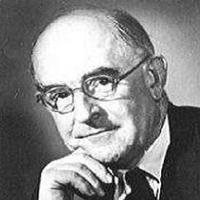 SPONSORED: Ensemble. Unjustly Neglected - In this specially extended feature, Armstrong Gibbs' re-discovered 'Passion according to St Luke' impresses Roderic Dunnett.
SPONSORED: Ensemble. Unjustly Neglected - In this specially extended feature, Armstrong Gibbs' re-discovered 'Passion according to St Luke' impresses Roderic Dunnett.
All sponsored features >>
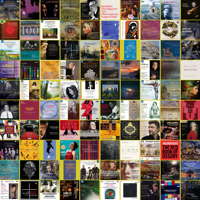 UPDATES: There's a new feature every day at Classical Music Daily. Read about the various ways we can keep in touch with you about what's happening here.
UPDATES: There's a new feature every day at Classical Music Daily. Read about the various ways we can keep in touch with you about what's happening here.
Twentieth Century Colours
GIUSEPPE PENNISI is impressed by a concert given by the orchestra of the Accademia Nazionale di Santa Cecilia
Before embarking on a two-week tour which will take them to Vienna, Munich, Frankfurt, Essen, Hamburg, Paris and Luxembourg, the Orchestra of the National Santa Cecilia Academy, with music director (since 2005) Antonio Pappano, offered three repeats of one of the three programs that will be taken on tour. I was at the third performance on 21 January 2023, in a very crowded hall - about 3,000 seats - also because it had been announced, as pianist, the eighty-two-year-old Martha Argerich (who cancelled both the three concerts and the tour), a name still of great appeal, especially among the Roman public.
Icelandic pianist Víkingur Ólafsson replaced her. He will also play in some concerts on the tour. He is called 'the new superstar of classical piano' and The New York Times has dubbed him the 'Glenn Gould of Iceland'. Ólafsson, tall and good-looking, is also known as a great communicator for his programmes for the BBC. Born in 1984, his recordings for Deutsche Grammophon have reached more than four-hundred-million streams.
The concert was entitled I colori del Novecento (The colors of the Twentieth Century). In fact, the music concerned the first decades of the last century. The evening was opened by the Symphony No 1, 'Classical', by Sergei Prokofiev. Among the Russian composer's most famous compositions, the symphony - which in the four-movement system follows the classical model combining modernity and tradition - was completed in September 1917 and the premiere was conducted by the composer himself in April 1918 in St Petersburg, enjoying a warm success. The second piece was Maurice Ravel's Concerto in G, conceived 'in the spirit of Mozart and Saint-Saëns', as Ravel himself wrote. The second movement, Larghetto, is a long piano monologue that almost recalls a Chopin Nocturne. The program concluded with Jean Sibelius' Fifth Symphony. Structured in three movements, this symphony closes with an Allegro molto, one of the Finnish composer's most inspired pages, also famous for the theme intoned by horns and trombones, known as the theme 'of the swans' because Sibelius told of having drawn inspiration from the flight of a flock of swans.
Two the main features of the evening: a) the strong affection between Antonio Pappano (who will soon be principal conductor of the London Symphony Orchestra and will hold the position of conductor emeritus of the Cecilian symphony) and the orchestra; b) some perplexity about the multi-acclaimed Víkingur Ólafsson.
Much has been written about Sergei Prokofiev's Classical Symphony, precisely in an attempt to define a collocation: still classical-nineteenth-century or anticipation of a neoclassicism of which Igor Stravinsky would later be the standard-bearer. In fact, Pappano and the orchestra showed masterfully how, in this work of just a quarter of an hour, Prokofiev was able to reconcile tradition with the innovation of his time. The symphony perfectly reflects the elegant eighteenth-century style. His classicism is stylized, but also extremely refined, always imbued with light irony and constantly supported by a rhythmic base that is one of the main connotations of Prokofiev's music. A composition written for an orchestra of the classical period - catchy, but not at all simple, full of harmonic novelties, sparkling sounds, wit and irony.
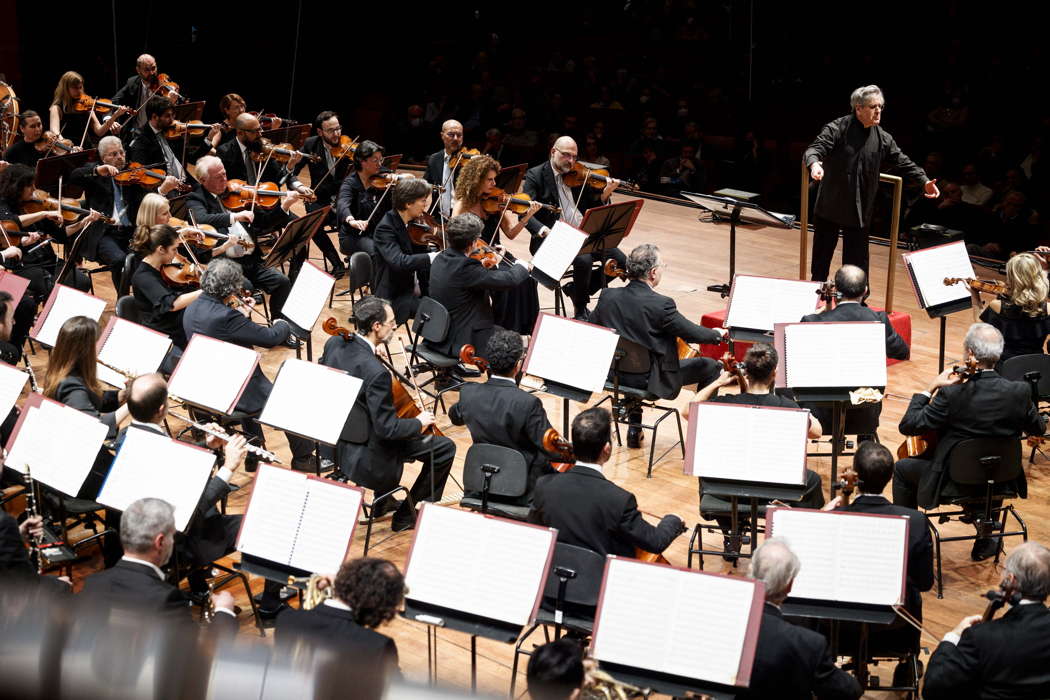
Antonio Pappano conducting the orchestra of the Accademia Nazionale di Santa Cecilia. Photo © 2023 Riccardo Musacchio
Maurice Ravel's Concerto in G for piano and orchestra was highly anticipated, also because, for decades, it was one of Martha Argerich's workhorses and now the occasion of Víkingur Ólafsson's Rome debut. It does not differ much from the composer's previous production in terms of color and musical design. You can hear the light and refined orchestration, defined by the choice of the fewest instruments chosen from all musical families - four brass, different types of woodwinds, a few strings and much percussion. There are the influences of other music, including a bit of jazz that Ravel had known for a long time, but only with the trip to the United States had touched with his own hands. There are Basque melodies and rhythms too.
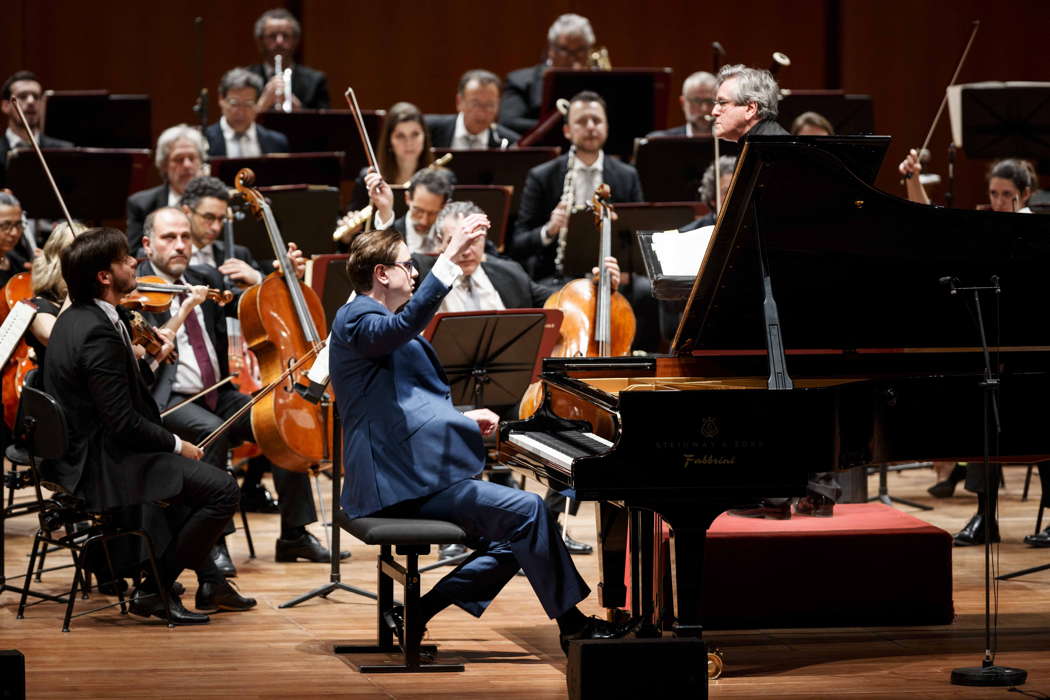
Víkingur Ólafsson playing Ravel in Rome with members of the orchestra of the Accademia Nazionale di Santa Cecilia. Photo © 2023 Riccardo Musacchio
In general, the performance was very good. The pianist has virtuoso moments in the first movement (Allegramente) and in the third (Presto). The second movement is fully 'his': a sweet Adagio in which the few orchestral interventions are entrusted to the harmonies of the strings and the light playing of five woodwind instruments - flute, oboe, cor anglais, clarinet and bassoon - in a post-impressionist and fully twentieth-century musical alternation. There was thunderous applause at the end, probably directed at both the orchestra and the soloist.
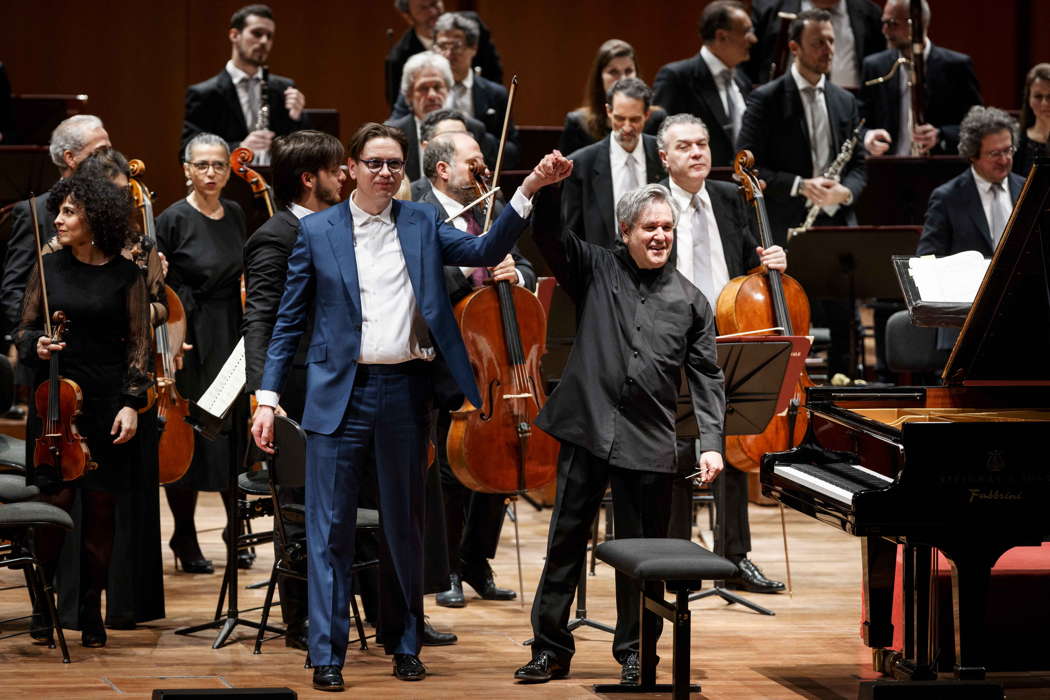
Víkingur Ólafsson with Antonio Pappano and members of the orchestra of the Accademia Nazionale di Santa Cecilia after the performance of Ravel's Concerto in G on 19 January 2023. Photo © 2023 Riccardo Musacchio
The handsome Víkingur Ólafsson most likely felt that this was all for him and, without being asked, offered two short encores: a prelude by J S Bach and the Sonata No 9 by Domenico Scarlatti. These were very good but not connected at all with the colors of the twentieth century. This was behavior as a 'star', rather than as an artist.
Performances in Rome of Jean Sibelius' Fifth Symphony are very frequent. Pappano and the orchestra, in great harmony, gave a descriptive reading, making you feel the ice, the lakes, the rivers and the grasslands of Finland - a great success, and even ovations, for Pappano and the orchestra.
Copyright © 23 January 2023
Giuseppe Pennisi,
Rome, Italy



